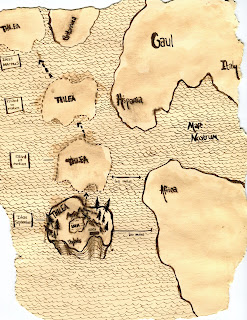Starting next month, we will begin posting campaign material for Servants of Gaius. We plan to provide characters, locations (cities, shops, etc), adventure ideas or scenarios and much more. I will also hopefully be furnishing Avalong Games with content (seperate from that appearing on the Bedrock Blog) for their monthly magazine: Game Geek.

For our blog content, I am encouraging fans to submit contributions. People have sent me some great ideas from their own campaigns and I would like to give fans of Servants of Gaius a platform to share their homebrew stuff. If we receive enough submissions then fan creations will be posted once a month. Anyone whose submission is selected will also receive a free Bedrock Games PDF of their choice. Down the road these may be bound into a free-pdf made available through places like RPGnow and Drivethru RPG.
If you are interested simply send your submission or idea to:
BedrockBrendan@gmail.com
Guidelines are pretty flexible. We would like to keep everything consistent though so I will make or request changes according to previous entries and the material in the corebooks. Here are some rough guidelines:
NPCS: Simply use the format establish in the Servants of Gaius rulebook (page 66, chapter 7). Include the name, defense skills, key skills, expertise (if applicable), vices (if applicable). The character description is divided into: Present, Past, Future (to assist with the divination skill). Any character is welcome. These can be newly invented personalities or historical personas from 38 AD (though you may want to check the rulebook to see who we already have).
Locations: This depends largely on what you submit. For cities use the Rome entry as a guide (page 98). For more specific locations like temples, tabernae, forums or ruins simply use your judgment. Because we are developing a series of province books, we will probably not be posting any province entries (simply to avoid confusion).
Adventure Ideas: This is a pretty open format. General I want to post four to five big adventure ideas for each entry. So 1-3 paragraphs for each idea is probably good.
Scenarios: These are longer and more involved than the Adventure Ideas. They still need to be compact enough for the blog format but could include a small investigation, an interesting scenario or encounter for any campaign.
Historical Essays: 500 to 2000 word articles on key topics in Roman history. Generally these should be written in present tense (38 AD) unless they deal with something that occured before the period of the game setting. These can be about anything (fish sauce production, associations, the legions, etc).
Monsters and Foes: Use the format established in the Servants of Gaius rulebook (page 82, chapter 9). This is similar to the character entry format except some monsters have special powers.
Gods: Send us your gods using the format established in the Servants of Gaius rulebook (page 90, chapter 10). These entries can be longer than those in the rulebook (since there our concern was space). Each god should be described and have a single major power. The power is not all the god can do, just his or her signature intervention.
Finally, submissions are not limited to the above categories. Feel free to contact me and suggest any ideas that aren't listed here.
Brendan







